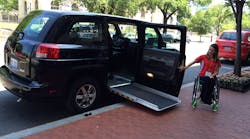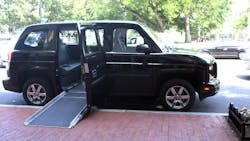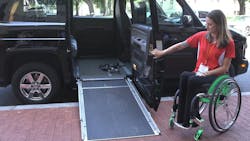One of those “options” is an unusual looking vehicle you may have seen plying the roads of major cities in taxi service: the MV-1 (seen at right), built by Mobility Ventures, a wholly owned subsidiary of AM General LLC, which builds the military’s famous Humvee.
The MV-1, though, is a little different: a body-on-frame truck that’s designed with wide interior space that can easily accommodate wheelchair-bound drivers. Pat Kemp, Mobility’s executive vice president, explained to me by phone that the design of the MV-1 allows those who need wheelchairs to sit up front like “regular passengers” instead of being loaded in the rear of vans modified for such use – modifications that mean wheelchair-bound folks end up sitting in the “way-way” back with the luggage.
Kemp also stressed to me that typical “paratransit” vehicles are typically shuttle buses, meaning their maneuverability is much more limited in tight urban areas. That’s where the MV-1 has a distinct advantage, he explained, as it resembles the footprint of an SUV more so than a bus.
“It’s not a ‘big clunky vehicle’ as we like to say,” Kemp pointed out.
“Mobility is critical to almost every aspect of our lives – our ability to work, to socialize, to go to doctor’s appointments – it is truly synonymous with freedom and independence. So improving access to transportation for people with disabilities will transform lives and communities.”To get some direct insight into that particular part of this transportation issue, I also got to speak with Erika Bogan (seen at left), one of Mobility’s marketing assistants and a former Ms. Wheelchair America.
Crippled by a car crash in 2002 at the age of 21, Bogan has three kids and is a big fan of the MV-1 because in her words “it gave me my dignity back” as a disabled driver.
“Now I can buckle my kids in first and then get into the driver’s seat,” she told me. “Before I had to have my children help me into the vehicle and buckle themselves.”
As a driver, Bogan likes that she sits sit up high in the MV-1 so she can see everything as there is “lots of window space,” in her view. In case you are wondering, she operates the vehicle using hand controls for acceleration and braking since she can’t use her legs.
“More important for drivers like me while it’s durable like a truck it rides like a sedan; that’s very important because driving on bumpy roads can be jarring on our spines,” she noted. “With this suspension I feel minimal bumps.”
Kemp added that the MV-1 is principally designed with two goals in mind: the dignity of the disabled driver and vehicle safety. “We engage in frontal test crashes with completed vehicles, ones fully converted to their final package,” he stressed. “The body-on-fame design gives it long-term durability but also more protection in a crash.”
Riding in the front is also better for disabled passengers as placing them in the rear “puts us in the crumple zone,” Bogan noted. “Also, when you unload from the rear of a converted van [in a wheelchair], there’s not enough room to exit forward so you have to exit backwards. That’s a huge safety issue because you can’t see where you are going.”
That’s a plus I think any driver or passenger can appreciate.





